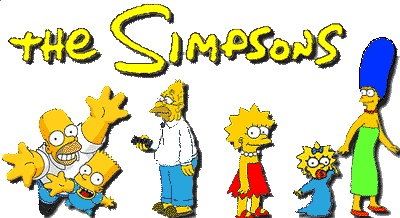
| SOSC
4318: Modes of Communication: "Reading Television?" Simpsons |

| Frasier |
| Friends.1 |
| Friends.2 |
| Simpsons |
| Sopranos |
| That 70's Show |

The Simpsons is the brainchild of Matt Groening, it was first aired in 1987 on the Fox network as an animated series. Just by looking at the show it comes across as being quite simple because they just use primary colours for everything in the show. What this does is takes attention off the characters per say and helps you focus more on the plots. The reason why we think it is so successful is because it appeals to many audiences. For example, children just watch the show and see a lot of slapstick comedy, whereas adults can decode a lot of the hidden humor behind many of the jokes in the show. Even after seeing 3 or 4 episodes of the Simpsons, one can quickly notice and pick up on new jokes which in turn helps for the longevity of this show.
The Simpsons show is based on the lives of Bart Simpson (Son), Lisa Simpson (Daughter), Maggie Simpson (Baby), Marge Simpson (Mother), and Homer Simpson (Father). The plots mainly revolve around their family and the things that happen to them in the town of Springfield. Even the show does revolve around these characters. There are many characters that are also in the show which help to take some of the comical weight off of the shoulders of this family. One of the things that one will notice about this show is that it plays off of many of the stereotypes that most would find very offensive. The reason why it doesn't come across as being that offensive in this show is because they push the extremes so far that all that you really can do is laugh. It is not worth getting upset about. Not only that, but they make fun of everyone and every race so there is no isolated group that is made fun of on a constant basis on this show.
To the average person this show may seem very stupid or far fetched. The Simpsons is just many people's way of seeing things from a dumb and funny point of view. Some people choose not to watch the show, but, as one can see, many people do like and choose to watch it on a weekly or daily basis.
The Simpsons project was undertaken to examine whether or not viewers "read" television. In order to get a better understanding of the show, we used four types of analysis: Audience Analysis, Content Analysis, Genre Theory, and Semiotic Analysis.
Jeffrey Lyons
Nabil Fakhoury
Tsung (Michael) Hsieh
Hussein Jahazi
York University, Toronto, Canada.


| Home | Assignment Purpose | Theory Summaries | Who We Are |

